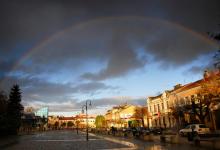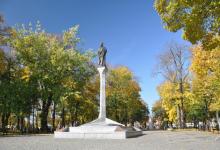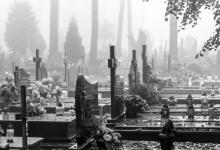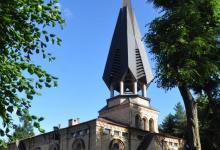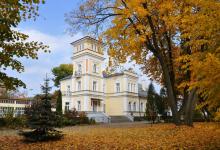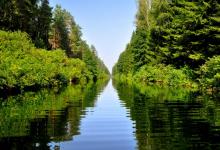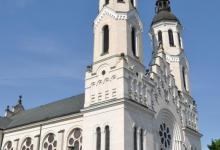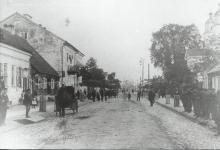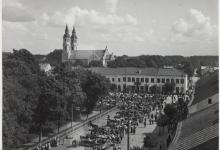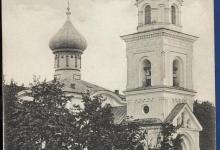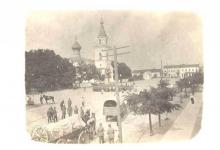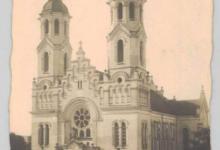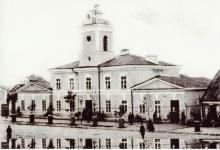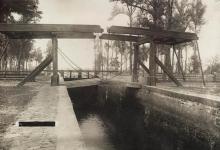Sights
While walking around town, you will come across many interesting sights, including:
Zygmunt August Market Square is the central point of the town, which was laid out in 1550 probably by the builder of royal fortresses Job Praetfuess. At the heart of the Market Square there is a park founded in 1847, formerly known as the Saxon Garden. Tenements around the market come mainly from the late nineteenth and early twentieth century. In the center of the park there is a column of Sigismund II Augustus and a fountain.
The Column of King Sigismund II Augustus was founded in 2007, to commemorate the 450th anniversary of the municipal rights granting. It was built at the initiative of inhabitants as a thanks to the founding father.
Tenement at No. 3 Zygmunt August Market Square decorated with an eclectic façade and ceramic ornaments has been a post office building since 1945.
Tenement at No. 8 Zygmunt August Market Square of 1896, built by Grodno merchant, Margolis.
Tenement at No. 9 Zygmunt August Market Square is the seat of the Municipal Cultural Centre. Before World War II it housed the Rowing Association and after 1956, the District Club of Culture
Tenement at No. 11 Zygmunt August Market Square of 1841, the design of the building was approved by the famous architect Antonio Corazzi.
Tenement at No. 28 Zygmunt August Market Square of 1801 called 'Napoleon's House' since on 8th December, 1812 Napoleon Bonaparte spent the night here.
Gravestones in the parish cemetery established in 1800. The oldest and most impressive tombstones are located around the cemetery chapel, founded by Truszkowski family in 1820. Several cast iron tombstones were made in the Sztabin Ironworks.
Jewish monument of 1981, it was founded by several Jewish families from the USA
PTTK Tourist House on Necko Lake (1938) had been designed by Maciej Nowicki, who was a co-author of the UN buildings in New York as well. It was destroyed during the war and rebuilt in 1948; it currently seats the Hetman Inn.
Soviet Military Cemetery, located in the north-west corner of the parish cemetery. The remains of 1,509 Soviet soldiers who had been killed and buried in the area were exhumed in 1948-1949.
Oficerski Yacht Club Pacyfic - designed by Juliusz Nagórski in 1935, hosted a renowned Military Holiday Resort (WDW) after the war. It was a place where Marshal Edward Rydz-Śmigły and Minister Józef Beck spent their holiday. Beside the building, by the lake you will find a monument shaped like a chair and stone commemorating the visit of Pope John Paul II in Augustów in 1999.
White House - before the war, it was a resort for the officers of the 1st Krechowce Uhlan Regiment.
President's Villa – a wooden building of 1934, which was used by the Polish Yacht Club that was frequently visited by President Ignacy Mościcki. During the Soviet occupation, the headquarters of the NKVD were located here, during the German occupation – it held Soviet POW's. The graves of murdered Russians are found not far, on the Dąbek peninsula.
Church of Our Lady of Częstochowa - originally was a Russian military Orthodox Church consecrated in 1912. Since 1921, it was the Augustów garrison church of the Polish Army. The tower hosts a memorial chamber for the Krechowce Uhlan Regiment.
Monument with the slogan "No more war" - commemorates inhabitants of Augustów who were killed during the Second World War. The ruins of a Polish combat bunker on the 'Augustów' defence line of 1939 are located there. The bunker was blown up by the Germans in 1944.
Bystry Canal - an artificial canal built between 1834 and 1835. It drains the excess water from the section of the Canal located above Netta River into Sajno Lake.
Cemetery of Jewish Victims in Augustów, Waryńskiego street, with the remains of dozens of people of Jewish nationality who died in World War II.
Water Management System Complex - an eclectic palace from approximately 1908. Before World War I, it was the management headquarters of the Vistula-German Waterway, and during the Soviet occupation, a border guard site with NKVD departments.
Augustów Canal Museum - the so-called Prądzyński Manor House, a branch of the Augustów History Museum focusing on the history of the Augustów Canal. The building itself is a reconstruction of the original nineteenth-century head office of the port. Manor House dates from the 80s of the nineteenth century. At the gate, you will find a monument commemorating victims of the massacre of prisoners from the NKVD prison of 22nd June 1941.
Augustów Canal - Monument of history, an outstanding work of Polish engineers and hydrologists from the 19th century. More about the Canal can be found here.
Augustów Lock – built between 1825 and 1826 by Lt. Konstanty Jodka, was destroyed in 1944. It was rebuilt in a new form in the years 1947-1948. At the Augustów lock, there is a monument to the fallen inhabitants of the Augustów area designed by Grzegorz Kosiarek.
Old Post Office, along with the park it is a typical design of H. Marconi from 1829. It used to be a horse changing station for sixteen horses, expedition and small hotel rooms for special guests. Tsar Nicholas I and Grand Duke Constantine stayed here. Currently, it is the seat of the Primary Music School. A rock situated in the park commemorates the builders of the Augustów Canal. It was placed there in 1973, on the 150th anniversary of the start of its construction.
Museum of Augustów History - Ethnographic Department at 7 Hoża street introduces visitors to methods and handicraft products (weaving, pottery, braiding), as well as appliances used in households, agriculture and fishing.
'Turk's' House no. 16 3 Maja street, built around 1900, according to the design of the district architect Włodzimierz Ślósarski. In the inter-war period Kiamil Takosz, a Bosnian, had a pastry shop here.
Minor Basilica of the Sacred Heart of Jesus was built of brick in neo-Romanesque style in years 1906-1911. The builder of the church was the Rev. Wincent Nowicki (pastor in years 1899-1924), and the designer Adam Piotrowski. The three-aisle church has five altars, all made in oak. In the main altar there is a painting of Our Lady of Częstochowa, at times it was covered by the image of the Heart of Jesus. The altars were made in the 1920s. The church was destroyed during the Second World War and rebuilt by Rev. Wojciech Chojnowski, the pastor in years 1945-1947. Next to the altar of St. Anthony's, you will find a Divine Mercy shrine with relics of St. Faustina Kowalska. In 2001, the church was given the title of Minor Basilica.
Marian Shrine in Studzieniczna (approximately 7 km from the centre of Augustów) - a wooden church dedicated to Our Lady of the Scapular from 1847 and an even older bell tower. Tower is decorated with a beautiful cross made by a blacksmith. The church interior was decorated by folk artists with wood and deer antlers. An artificial dike with Stations of the Cross leads to the main sanctuary on the island. It is a Neo-Renaissance chapel of the Blessed Virgin Mary that boasts the image of Our Lady of Studzieniczna (the 18th century copy of the image of Jasna Góra in Częstochowa). Next to the chapel, you will find a well with miraculous water covered with a shingle roof shed. On the shore of the lake there is a statue of Pope John Paul II, commemorating his visit here in June 1999.






